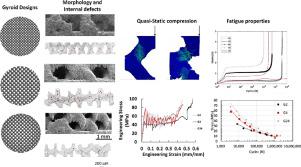当前位置:
X-MOL 学术
›
Int. J. Mech. Sci.
›
论文详情
Our official English website, www.x-mol.net, welcomes your feedback! (Note: you will need to create a separate account there.)
The Influence of Selective Laser Melting Defects on the Fatigue Properties of Ti6Al4V Porosity Graded Gyroids for Bone Implants
International Journal of Mechanical Sciences ( IF 7.3 ) Pub Date : 2021-03-01 , DOI: 10.1016/j.ijmecsci.2020.106180 Dalia Mahmoud , Kassim S. Al-Rubaie , Mohamed A. Elbestawi
International Journal of Mechanical Sciences ( IF 7.3 ) Pub Date : 2021-03-01 , DOI: 10.1016/j.ijmecsci.2020.106180 Dalia Mahmoud , Kassim S. Al-Rubaie , Mohamed A. Elbestawi

|
Abstract Porosity grading of metallic lattice structures is becoming a favorable design for bone implant applications since these structures mimic the bone mechanical and biological properties. Especially when using bio-mimetic unit cell designs created by triply periodic minimal surfaces (TPMS), such as gyroids, making these types of lattice structures dominant over other CAD-based designs. In this study, the manufacturability of gyroids is tested by studying three different designs: uniform porosity with thin struts (G2), thick struts (G4), and graded porosity (G24). The main aim is to understand the influence of selective laser melting (SLM) defects on the static and fatigue properties of uniformly and porosity graded gyroids. Qualitative and quantitative analysis revealed some dimensional deviation between nominal designs and printed parts. A finite element analysis (FEA) model based on a single unit cell is developed to predict the mechanical properties of uniformly graded porosity parts. The numerical results give insight into how manufacturing irregularities can affect the mechanical properties of lattice structures. Both G24 and G4 designs showed higher apparent modulus of elasticity (Eapp) and higher compressive strength (σp), whereas they both exhibited less fatigue strength than the G2 designs. It was observed that the Eapp was significantly affected by geometrical errors in strut shape. At the same time, fatigue strength was dependent on the surface quality and the internal defect percentage.
中文翻译:

选择性激光熔化缺陷对用于骨植入物的 Ti6Al4V 孔隙度分级陀螺仪疲劳性能的影响
摘要金属晶格结构的孔隙度分级正成为骨植入物应用的有利设计,因为这些结构模仿骨的机械和生物特性。尤其是在使用由三重周期性最小曲面 (TPMS) 创建的仿生晶胞设计时,例如陀螺仪,使这些类型的晶格结构优于其他基于 CAD 的设计。在这项研究中,通过研究三种不同的设计来测试 gyroids 的可制造性:均匀孔隙率与薄支柱 (G2)、厚支柱 (G4) 和梯度孔隙率 (G24)。主要目的是了解选择性激光熔化 (SLM) 缺陷对均匀和孔隙度分级陀螺仪的静态和疲劳性能的影响。定性和定量分析揭示了标称设计和印刷部件之间的一些尺寸偏差。开发了基于单个晶胞的有限元分析 (FEA) 模型来预测均匀梯度孔隙率零件的机械性能。数值结果深入了解制造不规则如何影响晶格结构的机械性能。G24 和 G4 设计均显示出更高的表观弹性模量 (Eapp) 和更高的压缩强度 (σp),而它们的疲劳强度均低于 G2 设计。据观察,Eapp 受到支柱形状几何误差的显着影响。同时,疲劳强度取决于表面质量和内部缺陷百分比。数值结果深入了解制造不规则如何影响晶格结构的机械性能。G24 和 G4 设计均显示出更高的表观弹性模量 (Eapp) 和更高的压缩强度 (σp),而它们的疲劳强度均低于 G2 设计。据观察,Eapp 受到支柱形状几何误差的显着影响。同时,疲劳强度取决于表面质量和内部缺陷百分比。数值结果深入了解制造不规则如何影响晶格结构的机械性能。G24 和 G4 设计均显示出更高的表观弹性模量 (Eapp) 和更高的压缩强度 (σp),而它们的疲劳强度均低于 G2 设计。据观察,Eapp 受到支柱形状几何误差的显着影响。同时,疲劳强度取决于表面质量和内部缺陷百分比。据观察,Eapp 受到支柱形状几何误差的显着影响。同时,疲劳强度取决于表面质量和内部缺陷百分比。据观察,Eapp 受到支柱形状几何误差的显着影响。同时,疲劳强度取决于表面质量和内部缺陷百分比。
更新日期:2021-03-01
中文翻译:

选择性激光熔化缺陷对用于骨植入物的 Ti6Al4V 孔隙度分级陀螺仪疲劳性能的影响
摘要金属晶格结构的孔隙度分级正成为骨植入物应用的有利设计,因为这些结构模仿骨的机械和生物特性。尤其是在使用由三重周期性最小曲面 (TPMS) 创建的仿生晶胞设计时,例如陀螺仪,使这些类型的晶格结构优于其他基于 CAD 的设计。在这项研究中,通过研究三种不同的设计来测试 gyroids 的可制造性:均匀孔隙率与薄支柱 (G2)、厚支柱 (G4) 和梯度孔隙率 (G24)。主要目的是了解选择性激光熔化 (SLM) 缺陷对均匀和孔隙度分级陀螺仪的静态和疲劳性能的影响。定性和定量分析揭示了标称设计和印刷部件之间的一些尺寸偏差。开发了基于单个晶胞的有限元分析 (FEA) 模型来预测均匀梯度孔隙率零件的机械性能。数值结果深入了解制造不规则如何影响晶格结构的机械性能。G24 和 G4 设计均显示出更高的表观弹性模量 (Eapp) 和更高的压缩强度 (σp),而它们的疲劳强度均低于 G2 设计。据观察,Eapp 受到支柱形状几何误差的显着影响。同时,疲劳强度取决于表面质量和内部缺陷百分比。数值结果深入了解制造不规则如何影响晶格结构的机械性能。G24 和 G4 设计均显示出更高的表观弹性模量 (Eapp) 和更高的压缩强度 (σp),而它们的疲劳强度均低于 G2 设计。据观察,Eapp 受到支柱形状几何误差的显着影响。同时,疲劳强度取决于表面质量和内部缺陷百分比。数值结果深入了解制造不规则如何影响晶格结构的机械性能。G24 和 G4 设计均显示出更高的表观弹性模量 (Eapp) 和更高的压缩强度 (σp),而它们的疲劳强度均低于 G2 设计。据观察,Eapp 受到支柱形状几何误差的显着影响。同时,疲劳强度取决于表面质量和内部缺陷百分比。据观察,Eapp 受到支柱形状几何误差的显着影响。同时,疲劳强度取决于表面质量和内部缺陷百分比。据观察,Eapp 受到支柱形状几何误差的显着影响。同时,疲劳强度取决于表面质量和内部缺陷百分比。


























 京公网安备 11010802027423号
京公网安备 11010802027423号